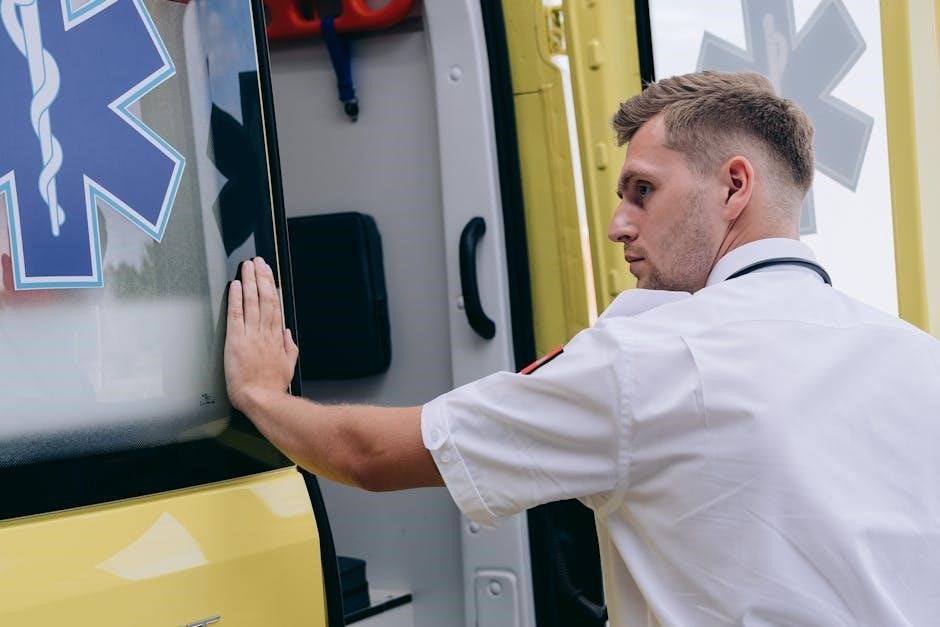EMS Field Guide: A Comprehensive Article Plan
This article provides a structured exploration of EMS field guides, covering essential aspects from their core features and vital BLS content to specialized applications and continuing education, ensuring comprehensive understanding.
EMS field guides serve as critical resources for emergency medical service professionals. Designed for quick access to essential information, these guides aid in efficient and effective patient care. From seasoned paramedics to beginning EMTs, these guides offer invaluable support in high-pressure situations. They provide immediate access to protocols, medication dosages, and critical decision-making tools. EMS field guides are frequently updated to reflect the latest advancements in medical practices and protocols. Often pocket-sized and durable, they withstand the rigors of field use. The guides ensure consistent application of best practices across various emergency scenarios, ultimately improving patient outcomes and supporting medical personnel.
Key Features of an Effective EMS Field Guide
Effective EMS field guides prioritize durability, portability, quick information access, and water resistance. These features ensure longevity and usability in demanding emergency environments, empowering rapid and informed decision-making.
Durability and Portability
EMS field guides require exceptional durability to withstand harsh conditions encountered in emergency settings. Constructed from robust, water-resistant materials, they must endure frequent handling and exposure to the elements. Portability is equally crucial; the guide should be compact and lightweight, fitting easily into a pocket or medical bag for immediate access. A durable, pocket-sized guide ensures essential information is readily available, enabling EMTs and paramedics to make informed decisions swiftly. Color-coded tabs and a well-organized layout further enhance usability. These features are essential for providing rapid and effective patient care in dynamic environments, whether you are a student or a 20-year veteran.
Quick Access to Information
In emergency situations, rapid access to accurate information is paramount. An effective EMS field guide should facilitate immediate retrieval of critical data through clear organization and intuitive design. Color-coded sections, concise summaries, and readily accessible tables are essential for swift navigation. The guide should contain essential information such as medication dosages, ECG interpretations, vital signs, and treatment algorithms. Whether assessing APGAR scores, pediatric vital signs, or stroke scales, a well-structured field guide ensures that EMS professionals can quickly locate and apply the necessary knowledge to provide optimal patient care. This is crucial for both seasoned veterans and new EMTs, alike.
Water Resistance and Longevity
EMS environments are often unpredictable, exposing field guides to moisture, spills, and rough handling. Therefore, water resistance is a crucial feature to preserve the guide’s integrity and readability. Laminated pages or waterproof materials offer protection against liquids, ensuring that essential information remains accessible even in adverse conditions. Durability is equally important; the guide should withstand frequent use without tearing or falling apart. Reinforced bindings and robust construction contribute to its longevity, making it a reliable companion for EMS professionals. Considering the investment in both time and resources, a durable and water-resistant field guide proves to be an invaluable tool for consistent and effective emergency care.

Essential Content for BLS Field Guides
BLS field guides must contain quickly accessible information on key topics. These include APGAR scoring, pediatric vital signs, and stroke scales, ensuring rapid and accurate assessment in critical situations.
APGAR Scoring
APGAR scoring is a critical component of any BLS field guide, providing a standardized method for assessing a newborn’s condition immediately after birth. This rapid assessment tool evaluates five key areas: Appearance, Pulse, Grimace, Activity, and Respiration. Each area is scored from 0 to 2, resulting in a total score ranging from 0 to 10.
A high APGAR score indicates a healthy newborn, while a low score may signal the need for immediate medical intervention. The field guide should clearly outline the scoring criteria for each category, enabling EMTs to quickly and accurately assess the newborn’s well-being and initiate appropriate care.
Pediatric Vital Signs
Accurate assessment of pediatric vital signs is paramount in emergency medical situations. The BLS field guide must include age-appropriate normal ranges for heart rate, respiratory rate, and blood pressure. These values differ significantly from adults and vary greatly depending on the child’s age, from neonates to adolescents.
The guide should clearly present these ranges in an easy-to-reference table or chart, enabling EMTs to quickly identify any deviations from the norm. Furthermore, it should offer guidance on the proper techniques for obtaining these vital signs in children, considering the unique challenges posed by this patient population, ensuring accurate data collection for effective treatment.
Stroke Scales
Rapid and accurate stroke assessment is crucial for timely intervention and improved patient outcomes. The BLS field guide must incorporate a standardized stroke scale, such as the Cincinnati Prehospital Stroke Scale (CPSS) or the Los Angeles Prehospital Stroke Screen (LAPSS). These scales provide a structured approach to evaluating neurological deficits indicative of stroke.
The field guide should outline the specific components of the chosen stroke scale, including facial droop, arm drift, and speech abnormalities. Clear instructions and visual aids should be included to ensure consistent and reliable application of the scale in the prehospital setting, aiding in the early identification of potential stroke patients.

Advanced Life Support (ALS) Field Guide Focus
ALS field guides prioritize advanced interventions, including detailed medication information and ECG interpretation. These resources are vital for paramedics and advanced EMTs in critical patient care scenarios.
Medication Dosages and Administration
A crucial section within the Advanced Life Support (ALS) field guide focuses on medication dosages and administration. This segment provides rapid access to critical drug information, essential for paramedics, AEMTs, nurses, and physicians. The guide clearly outlines appropriate dosages based on patient weight and condition, ensuring accurate medication delivery in emergency situations. Furthermore, it details various routes of administration, including intravenous, intramuscular, and subcutaneous, offering comprehensive guidance for diverse clinical scenarios. Quick reference charts and algorithms assist in swiftly calculating dosages, minimizing errors during high-pressure situations. This section also includes information on potential side effects and contraindications, promoting safe and effective medication practices in the field, ultimately improving patient outcomes.
ECG Interpretation
The ALS field guide provides a dedicated section for ECG interpretation, a cornerstone of advanced emergency medical care. This segment offers a concise yet comprehensive overview of various cardiac rhythms, enabling quick identification of life-threatening arrhythmias. Clear diagrams and step-by-step algorithms guide users through the process of ECG analysis, facilitating accurate diagnoses in the field. Common ECG patterns, such as atrial fibrillation, ventricular tachycardia, and myocardial infarction, are presented with detailed descriptions and characteristic features. The guide also includes information on differentiating between various heart blocks and identifying subtle ECG changes indicative of ischemia or electrolyte imbalances. This section empowers EMS providers to make informed decisions regarding patient management and treatment strategies, improving outcomes for individuals experiencing cardiac emergencies. This rapid access to vital information is crucial.
Specialized EMS Field Guides: LVAD Recipients
EMS field guides tailored for LVAD (Left Ventricular Assist Device) recipients are crucial resources. These specialized guides help EMS personnel identify, troubleshoot, and provide emergency care for these patients, often containing specific protocols not covered in standard guides. They cover device-specific information, including manufacturer variations like HeartWare HVAD, and address common complications such as pump malfunction, driveline infections, and bleeding. These guides emphasize the importance of contacting the LVAD coordinator or the patient’s cardiologist for guidance. Furthermore, they detail how vital signs may differ from those of a typical patient, such as the absence of a palpable pulse. The guides also offer algorithms for managing emergencies like hypotension and cardiac arrest, highlighting the unique considerations when treating LVAD patients. These guides are often available free, ensuring widespread access to critical knowledge improving patient outcomes.

The NJ EMS Field Guide
The New Jersey EMS Field Guide serves as a convenient and essential reference manual specifically designed for EMS professionals operating within New Jersey. It offers quick access to vital protocols, medications, and contact information necessary for effective emergency medical care. Available both online and as a downloadable resource, it ensures accessibility in various field conditions. The guide emphasizes adherence to state-specific regulations and guidelines. Its content is regularly updated to reflect the latest advancements in EMS practices and protocols within New Jersey. Furthermore, it includes sections on communication etiquette, stressing the appropriate use of EMS frequencies and maintaining patient confidentiality. It’s a crucial tool for both seasoned paramedics and new EMTs, aiding in rapid decision-making and enhancing patient care throughout the state. Its comprehensive nature supports the delivery of standardized and high-quality emergency medical services across New Jersey.

Continuing Education and Field Guide Updates
Ongoing professional development is crucial in the ever-evolving field of emergency medical services. Continuing education ensures that EMTs and paramedics remain current with the latest medical advancements, protocols, and best practices. EMS field guides are not static documents; they require regular updates to reflect these changes. Updates incorporate new medications, revised dosages, and refined treatment algorithms. These updates are often integrated into continuing education programs. Providers should actively participate in refresher courses and training sessions that highlight revisions to the field guide. Staying informed about updates ensures accurate decision-making and optimal patient care in emergency situations. Furthermore, continuous learning enhances the provider’s ability to effectively utilize the field guide as a quick and reliable reference tool. Access to updated guides is often provided through online platforms or professional development programs that emphasize the importance of continuous professional growth within EMS. This commitment to learning safeguards quality patient outcomes.

No Responses